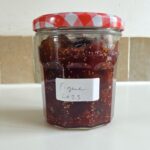
Fig jam
Fresh figs are easily turned into jam because no pitting of the fruit is involved. If you’re happy making just 2-3 jars, the entire process takes less than half an hour. And this includes sterilizing the jam jars.
 For best results, use the freshest figs you can find. I generally make fig jam with black figs, but the green variety should work just as well. As for the jars, I use recycled (store-bought) jam jars with screw-on lids. When the lids are screwed on tightly over the hot jam, a vacuum will form. This preserves the jam — and eliminates the need for paraffin.
For best results, use the freshest figs you can find. I generally make fig jam with black figs, but the green variety should work just as well. As for the jars, I use recycled (store-bought) jam jars with screw-on lids. When the lids are screwed on tightly over the hot jam, a vacuum will form. This preserves the jam — and eliminates the need for paraffin.
As with so many aspects of life, it’s important when making jam to know when to stop. Overcooking the fruit produces jam like concrete, while undercooking can leave you with watery jam. With figs, I recommend 15 minutes once the fruit boils.
The quantities below will make two 1-cup (25 cl) jars of jam. If you have extra, just ladle it into a glass, refrigerate when cool and enjoy over the next few days.
1-1/2 pounds (700 g) fresh figs
1-1/4 cup (250 g) sugar
1/2 lemon
1 small branch rosemary
2-3 clean jam jars with screw-on lids
Rinse the figs. Slice off the hard bit of stem and cut in half (for smaller figs) or in quarters (for larger figs). Transfer to a large pot.
Pour the sugar over the figs. Stir to coat. Squeeze the lemon through a sieve over the fruit. Add the rosemary branch.
Set the figs over medium-low heat, stirring occasionally until they release their juice.
At the same time, set a separate large pot of water over high heat. When it boils, you will sterilize your jam jars.
When the figs have released their juice and the sugar has melted, turn up the heat to medium-high. From the moment the juice starts to boil, cook for 15 minutes.
While the figs are cooking, lay a clean dish towel (tea towel) on the counter.
Remove the lids from your jam jars. Immerse the jars and lids in the boiling water. The jars may sit upright, but they should be at least half filled with water. Boil for two minutes, then carefully remove and set upside down on the towel. (Over the years, I’ve found that the best way to lift the jars and lids out of the water is with a soup spoon and a fork.)
Meanwhile the jam is still cooking. Test it to see if it’s ready. Retrieve half a spoonful and tip onto a plate. If the jam holds together, it’s done. If the juice is runny, then it needs to cook a little bit more.
As soon as the jam is done, turn off the heat. Remove the rosemary branch, then immediately ladle the hot jam into the sterilized jars. Do not fill to the brim — leave about 1/3 inch (1 cm) of space at the top. Quickly screw on the lids. It may be hard to screw them on tightly because the jars are hot — in which case use a towel to hold the jar, then twist the cap on tightly. This will create a vacuum as the jam cools.
 Use a sponge to wipe away any jam from the sides of the jars. Label the jars with the type of jam and the year. Then store in a cool dark place. The jam will keep for up to five years — if you can wait that long.
Use a sponge to wipe away any jam from the sides of the jars. Label the jars with the type of jam and the year. Then store in a cool dark place. The jam will keep for up to five years — if you can wait that long.




